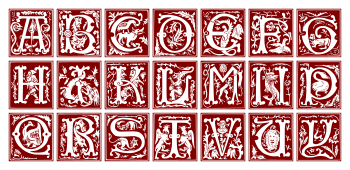Talk:Initial
| This article is rated Start-class on Wikipedia's content assessment scale. It is of interest to the following WikiProjects: | |||||||||||
| |||||||||||
Drop cap
"Drop cap" redirects here. Are they synonyms or is there a difference? -- Tarquin 15:11, 29 August 2005 (UTC)
- The terms tend to be used synonymously, but I think they are slightly different things, if you want to be picky. An initial cap means any kind of large initial letter, including a drop cap, whereas I think a drop cap is a more specific kind of initial cap (probably the most common kind) that drops below the baseline of the text that follows on? So initial cap is the more general term? 82.71.0.229 (talk) 10:46, 5 February 2018 (UTC)
Self-reference
There is no reason for the example text to begin with a sentence about Wikipedia... wouldn't Lorem ipsum suffice? ~
- From Black, Roger (1991). Roger Black's Desktop Design Power. Bantam. p. p. 61. ISBN 0553347527.]
{{cite book}}:|page=has extra text (help): "For some reason, writers always seem to start paragraphs with an 'I' or a 'T,' rectilinear letters which don't add much to a page and can get repetitious in a hurry." Presumably, the same holds for L. NeonMerlin 14:56, 1 September 2006 (UTC) - I removed the self reference: [1]. It does look strange though because of the link. Perhaps the text should start with "The quick brown fox jumps over the lazy dog"? PleaseStand (talk) 23:06, 15 February 2010 (UTC)
Merge
It doesn't seem a good idea to me. Historiated could not be placed very prominently in Initial, and can be hugely expanded. Johnbod (talk) 03:59, 3 January 2009 (UTC)
HTML and Initial
Most of the hints to HTML in this page refer to blatantly bad advice. Tables as a layout device is an abuse and has been deprecated for years; also, there's no need to make the capital float. CSS3 offers a first-line and a first-letter pseudo-elements, that are fully supported in Opera, Safari and Firefox, but not in IE7 (I don't know about IE8). The correct HTML/CSS markup and style is a clean markup (in fact, the first letter has no special semantic value) and the use of said pseudo-elements in the stylesheet.
If nobody has anything to say about this, I'll go and edit the page, as I think it is highly "mis-educational" for web developers. Sk (talk) 14:58, 16 August 2009 (UTC)
File:Ornamental Alphabet - 16th Century.svg to appear as POTD soon
Hello! This is a note to let the editors of this article know that
In non-Latin scripts?
Are or were initials used in non-Latin scripts as well? I think I've seen them at least in a Greek bible once, but it would be nice if somebody with more knowledge could add some info on this. -- 77.7.148.124 (talk) 18:34, 5 October 2010 (UTC)
Not merely decorative
Don't have time to edit the article but would greatly appreciate some info about the purpose of drop caps in modern publications. They don't just decorate (as this article implies); they also communicate: they serve as a focus for the eye and help the reader to zoom in on the start of the body text. For me, this article is overly skewed towards historical uses and illuminated manuscripts where that idea of focusing the reader's attention is lost or confused, so a separate section on this might be good? 82.71.0.229 (talk) 10:40, 5 February 2018 (UTC)
Can we start this article with a drop capital?
It would be very fitting for this article, would it not? --31.205.88.138 (talk) 15:53, 26 November 2019 (UTC)
Initial as in John "F." Kennedy?
That term middle initial redirects to middle name, but there is not a word about it there. In America, at least, people often ask Does that person use an initial, to which could be added , like John. F. Kennedy?. Wouldn't it be a good idea to explain clearly what that "F." is. What's that "F." in John F. Kennedy called, what's the term for it? Who knows? Wikipedia doesn't. Major flaw here. --SergeWoodzing (talk) 14:50, 30 July 2020 (UTC)
- Middle name has " In the U.S., the "middle name" is often abbreviated to the middle initial (e.g. Mary Lee Bianchi becomes Mary L. Bianchi).[5] This is usually standard for signatures[citation needed] or omitted entirely in everyday use (e.g. just Mary Bianchi). An individual may have more than one middle name, or none. In the United Kingdom, for comparison, she would usually be referred to as either Mary Bianchi, M. L. Bianchi or Mary Lee Bianchi, or she may choose Lee Bianchi, and informally there may be familiar shortenings." Seems almost enough. I'll move this section to the proper place. Something could be added here, and at Initial (disambiguation) - this page is about initials on pages. Johnbod (talk) 14:55, 30 July 2020 (UTC)
- Sorry I missed it there, wading through just about everything to try to find something. Great if you add something here. We are not all typesetters or experts on that subject.--SergeWoodzing (talk) 14:58, 30 July 2020 (UTC)
- PS Could you please try to cover J. Edgar Hoover, etc also? Not all initials (U.S. very common lingo) are in the middle. --SergeWoodzing (talk) 15:00, 30 July 2020 (UTC)
- It already has "(header) Middle name as primary name (text) In the United States, those who choose to be known primarily by their middle name may abbreviate their first name as an initial, e.g. J. Edgar Hoover (John Edgar Hoover)." Not in the same place, I admit. I think the "see also" you've added is the way to go here. I'll add to the disam. Johnbod (talk) 15:12, 30 July 2020 (UTC)


